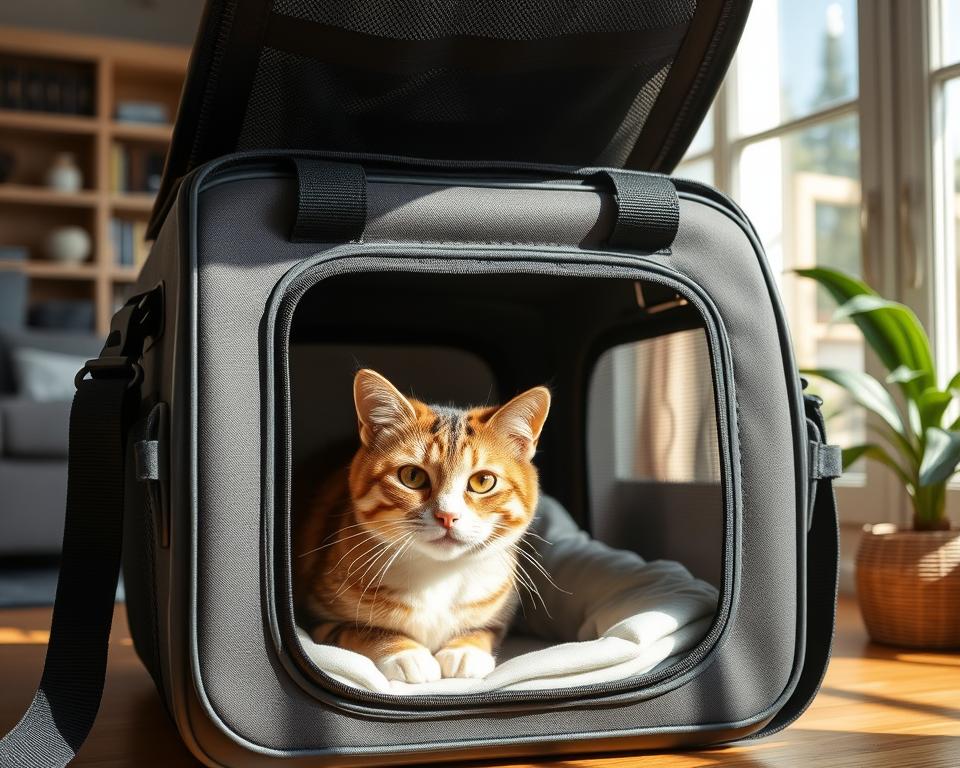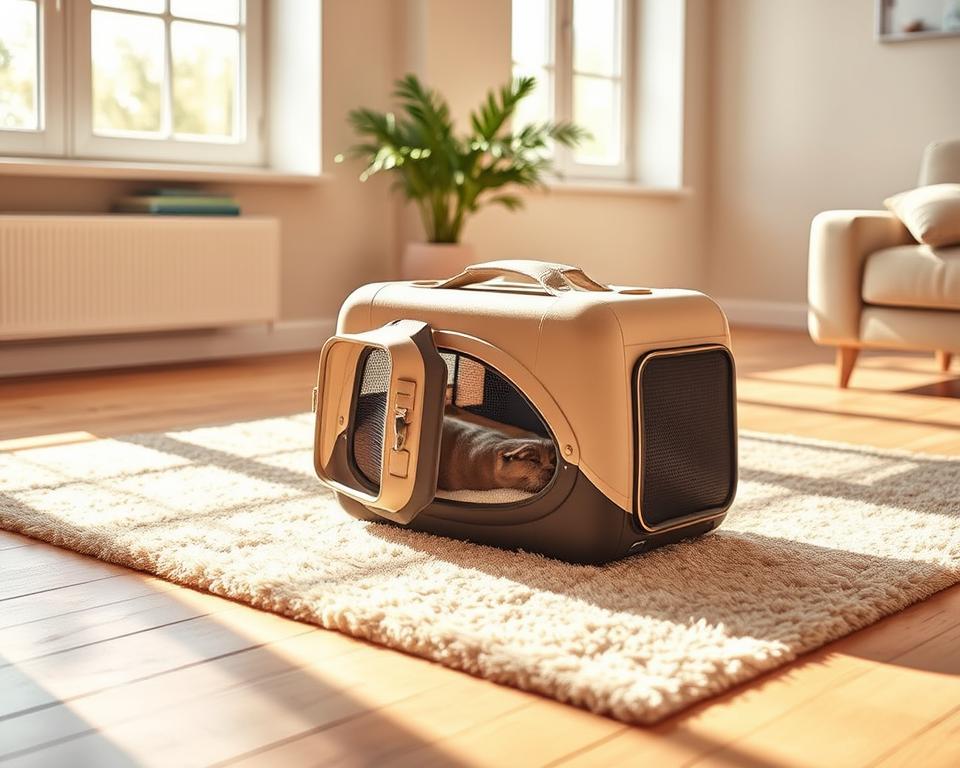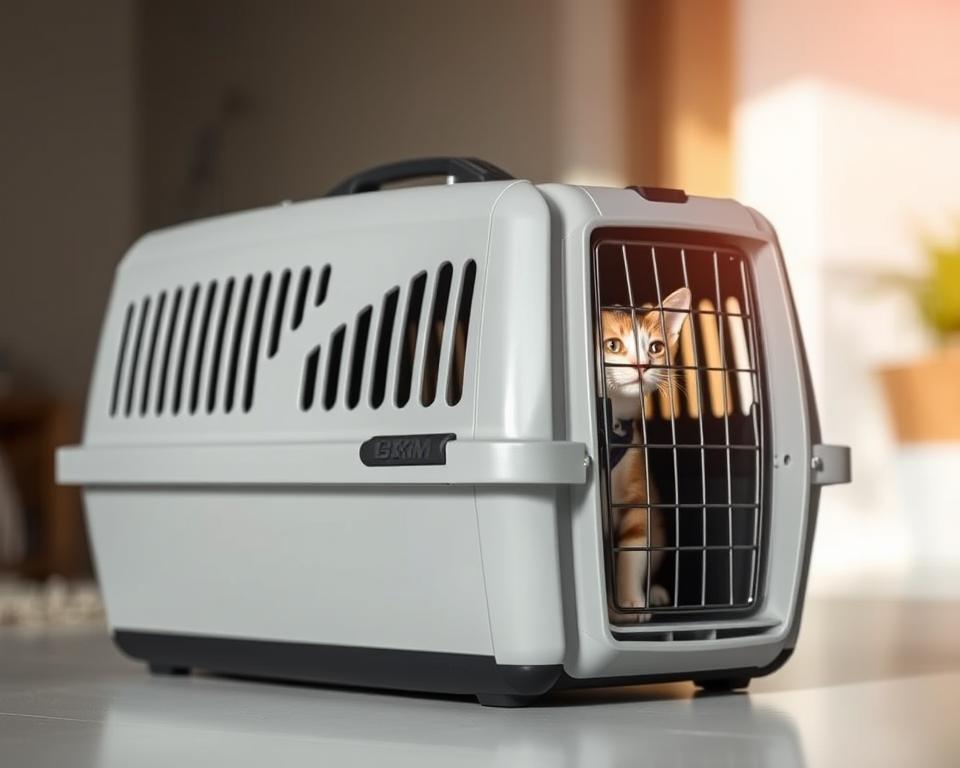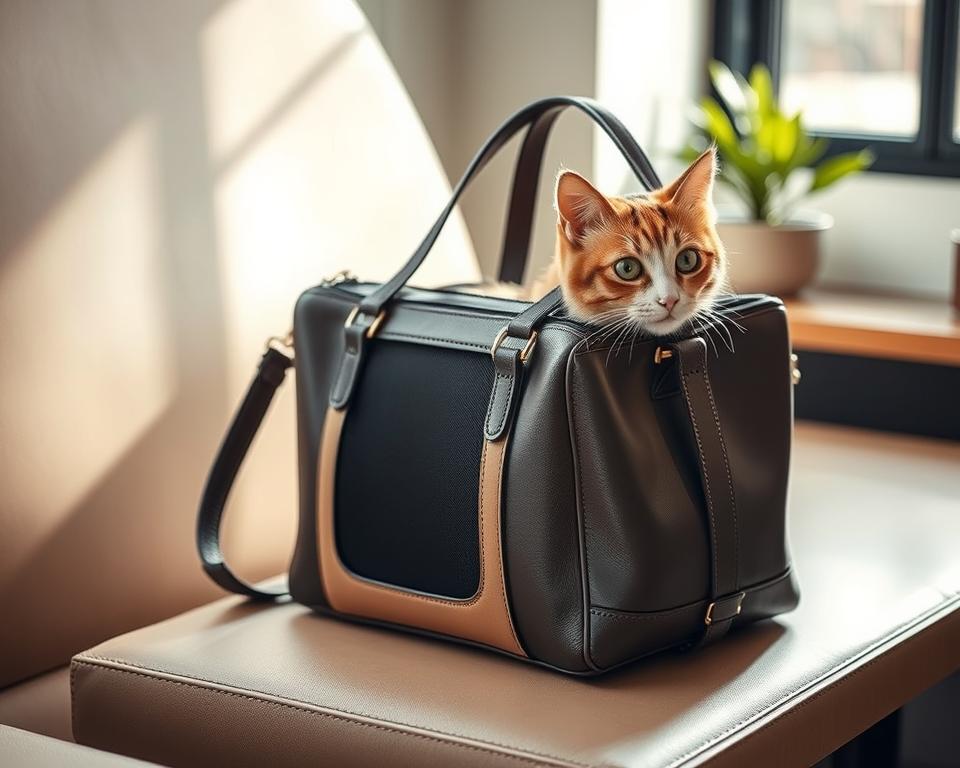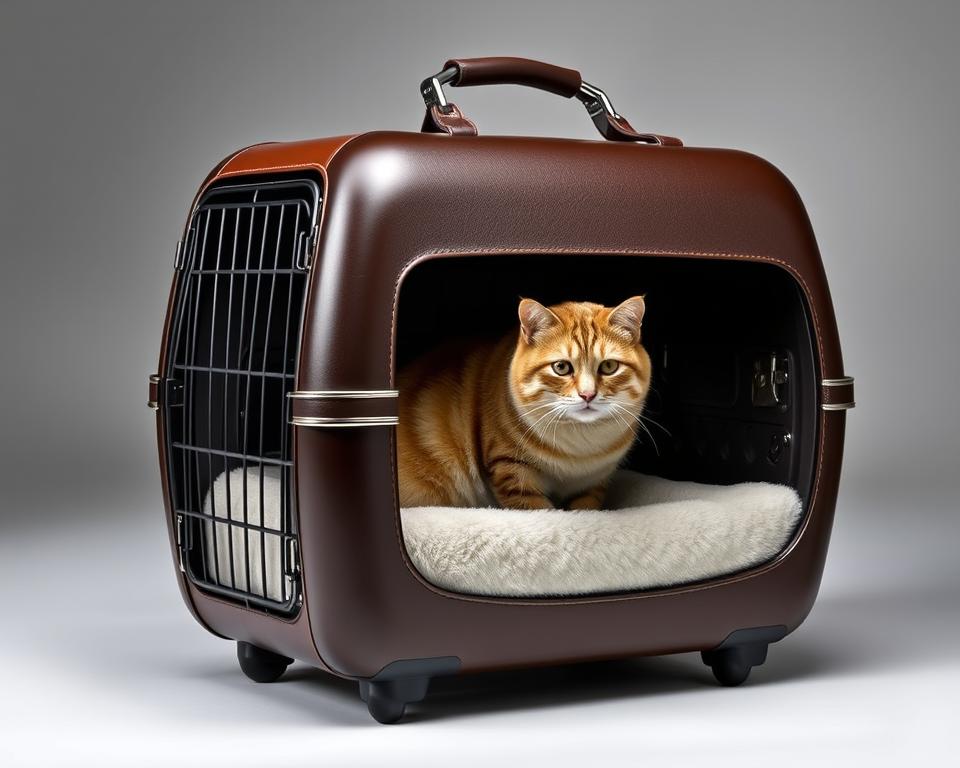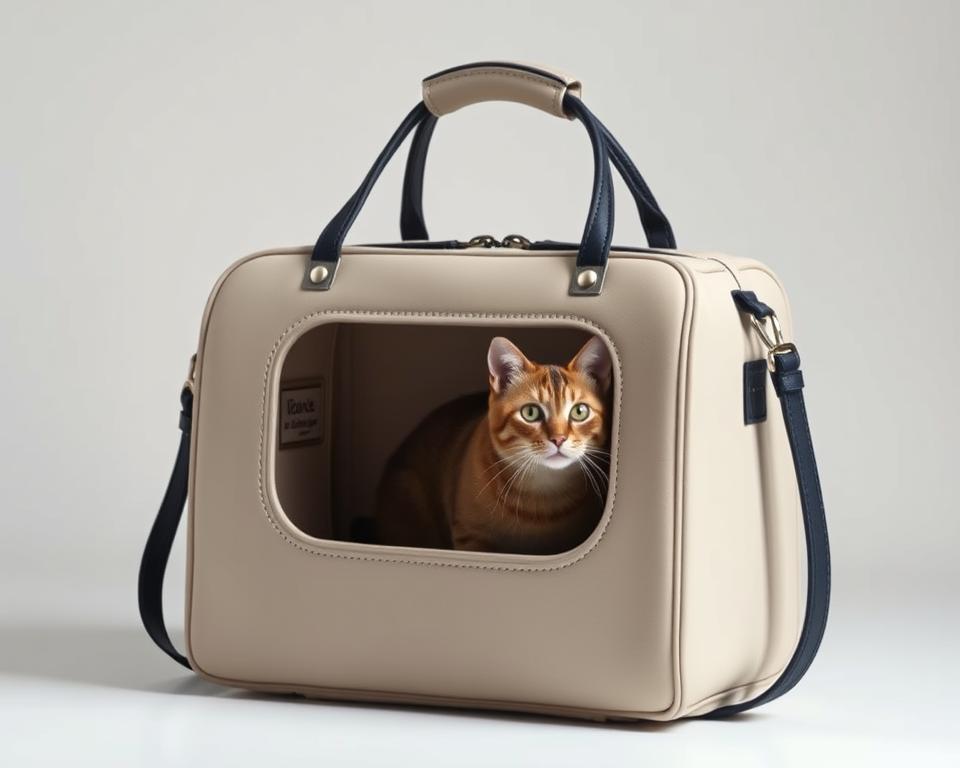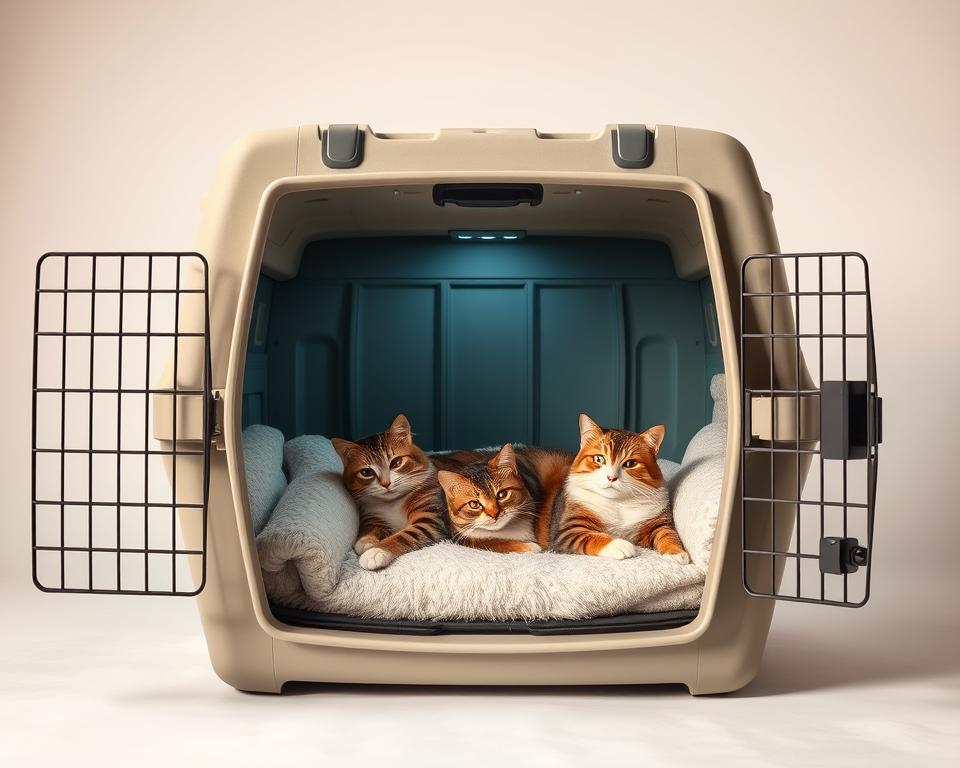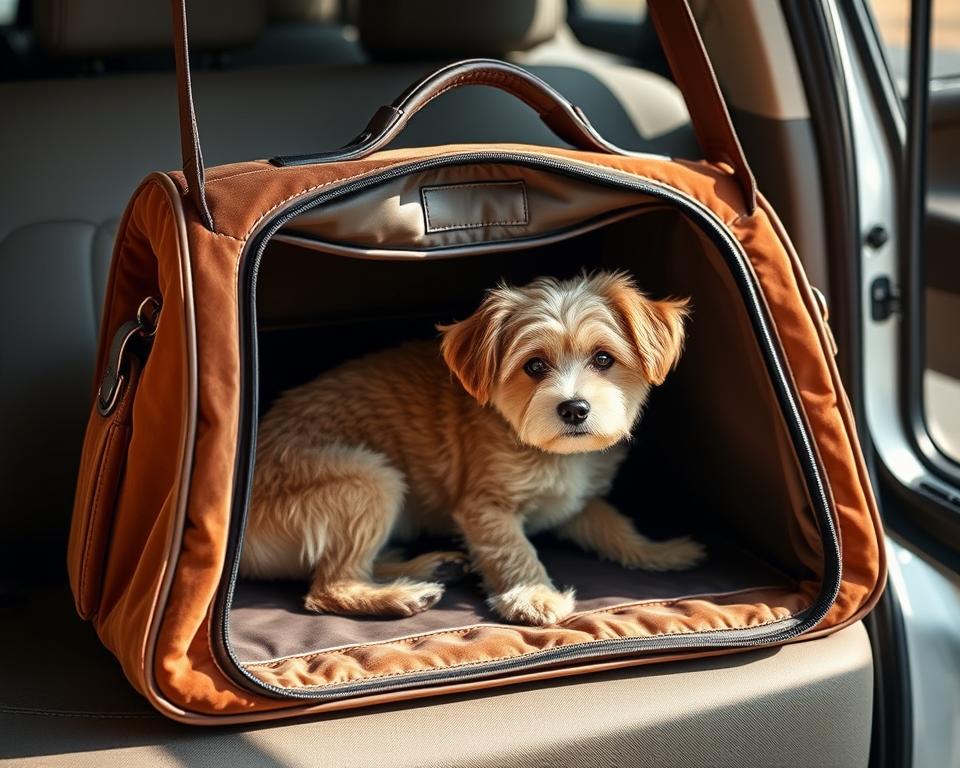Discover the Perfect “Good Cat Carrier” for Your Pet
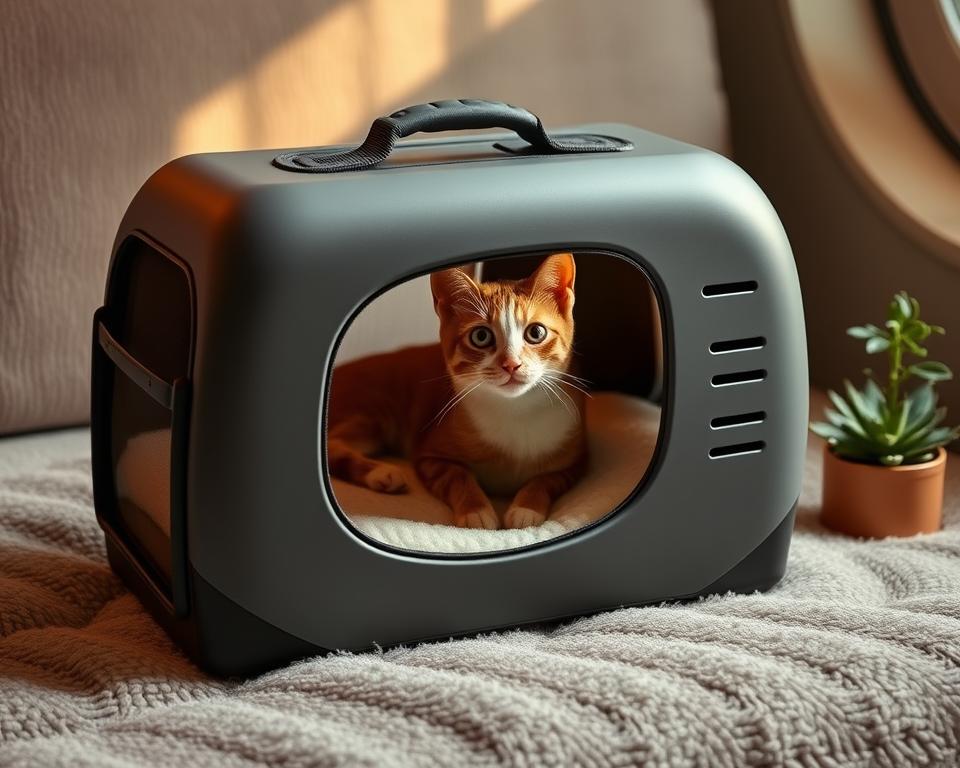
Traveling with your cat can be challenging. It’s important to make sure they are safe and comfortable. A staggering number of pet owners don’t realise how crucial a good pet carrier is. This can make trips stressful for both pets and their owners.
Finding the right cat travel carrier is key. It should let in air, be easy to clean, and big enough for your cat to move. Experts say the right carrier can really help reduce travel stress for cats.
When picking a carrier, think about its size, material, and how well it breathes. A good carrier can greatly improve your pet’s travel experience.
Key Takeaways
- Choose a carrier that is well-ventilated to prevent overheating.
- Opt for a carrier that is easy to clean to maintain hygiene.
- Ensure the carrier is spacious enough for your cat to move around.
- Consider the material and durability of the carrier.
- Select a carrier that provides comfort and reduces stress for your pet.
What Makes a Good Cat Carrier?
Finding the right cat carrier is key for your pet’s comfort and safety. It should be secure and comfy for your cat, whether you’re off to the vet or on a long trip.
Essential Features for Cat Comfort
A sturdy cat carrier is a must, but comfort is just as important. Choose one with good airflow to keep your cat cool and relaxed. Soft bedding or a comfy mat inside can also help a lot. Plus, a carrier with easy entry points can reduce stress for both you and your cat.
Experts say a hard-sided cat crate is best for cats that get car sick or scratch a lot. These crates offer a strong and safe space.
Safety Considerations
Safety is top priority with cat carriers. A good one should have a sturdy design to prevent escape or injury. Look for carriers with strong locks and tough materials that can handle scratching and biting. Also, a carrier with at least two openings is handy for quick access in emergencies.
When picking a cat carrier, think about the safety features it has. Look for reflective materials or safety straps for car travel.
Types of Cat Carriers Available in the UK Market
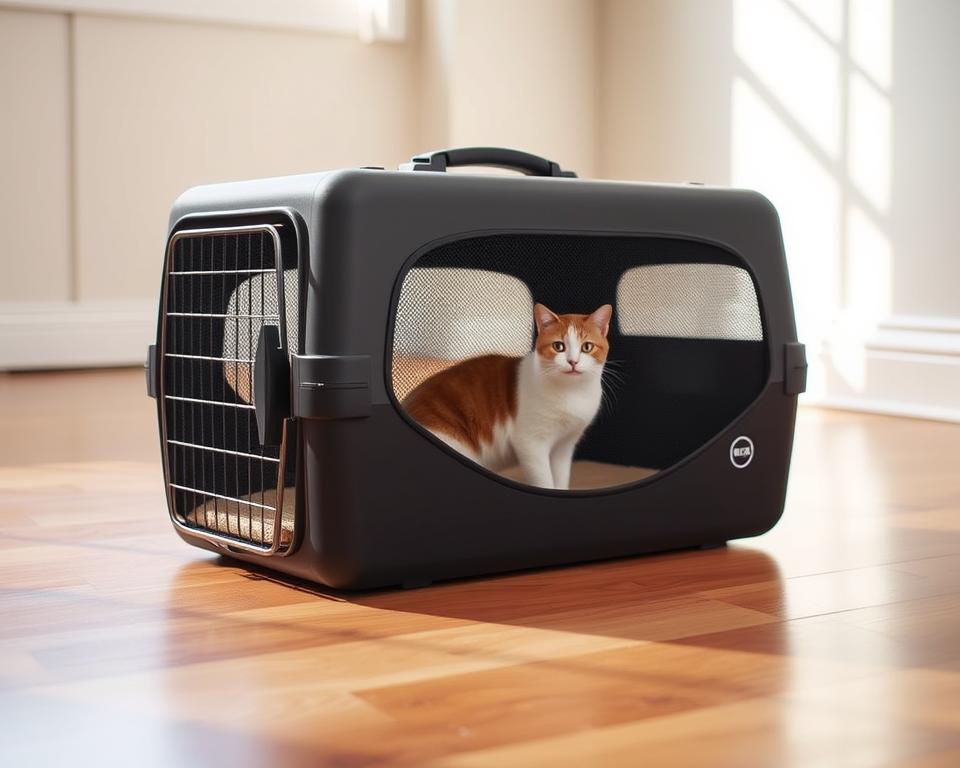
In the UK, there’s a wide range of cat carriers to choose from. Each one meets different needs, ensuring your cat is comfortable, safe, or easy to carry.
Hard-Sided Cat Carriers
Hard-sided cat carriers are tough and easy to clean. They’re made from sturdy plastic and keep your cat safe. They also have good air flow and are simple to clean. Check out a variety on meoggy.com.
Soft-Sided Cat Carriers
Soft-sided cat carriers are light and easy to carry. They’re great for cats that like a snug space and are best for short trips. Even though they’re not as tough as hard-sided ones, they’re made to last longer.
Cat Carrier Backpacks
Cat carrier backpacks let you carry your cat hands-free. They’re perfect for moving around easily or going on adventures. They come with comfy straps and places to store your cat’s things.
Expandable Cat Carriers
Expandable cat carriers are flexible. They let you change the size to fit your cat’s needs. They’re good for longer trips and have mesh for air and visibility.
Think about what your cat needs and what each carrier offers. This will help you pick the best cat carrier for your pet.
Size Matters: Choosing the Right Dimensions
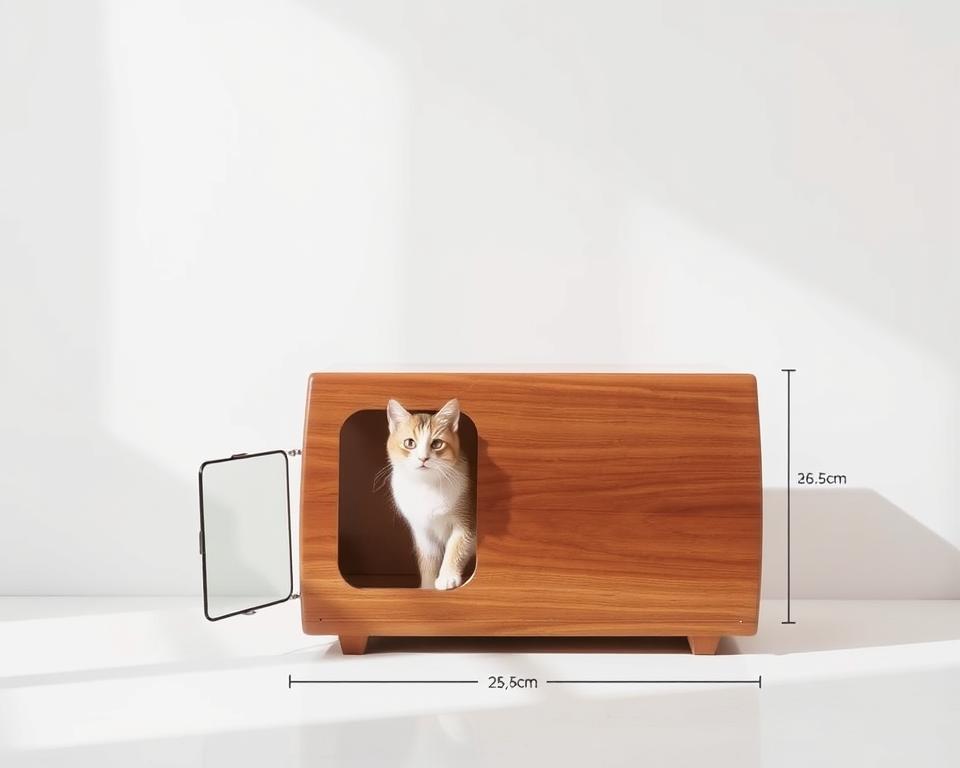
Choosing the right size cat carrier is crucial. A carrier that’s too small can be uncomfortable. On the other hand, one that’s too big might not offer the security your cat needs.
Measuring Your Cat Properly
To find the perfect size, measure your cat carefully. Start by measuring from their nose to the base of their tail. Then, measure from the top of their head to the ground. Finally, measure their width at the widest point. Use a flexible measuring tape for accurate measurements.
Accommodating Growth and Movement
A good carrier should let your cat stand up, turn around, and lie down easily. Choose a carrier that’s a bit bigger than your cat’s measurements. This allows for growth and movement. Below is a table showing the minimum dimensions for different cat sizes.
| Cat Size | Minimum Carrier Dimensions |
|---|---|
| Small | Length: 45cm, Width: 25cm, Height: 25cm |
| Medium | Length: 50cm, Width: 30cm, Height: 30cm |
| Large | Length: 60cm, Width: 35cm, Height: 35cm |
By picking the right size, you can make travel more comfortable and stress-free for your cat.
Materials and Durability: What to Look For in a Good Cat Carrier
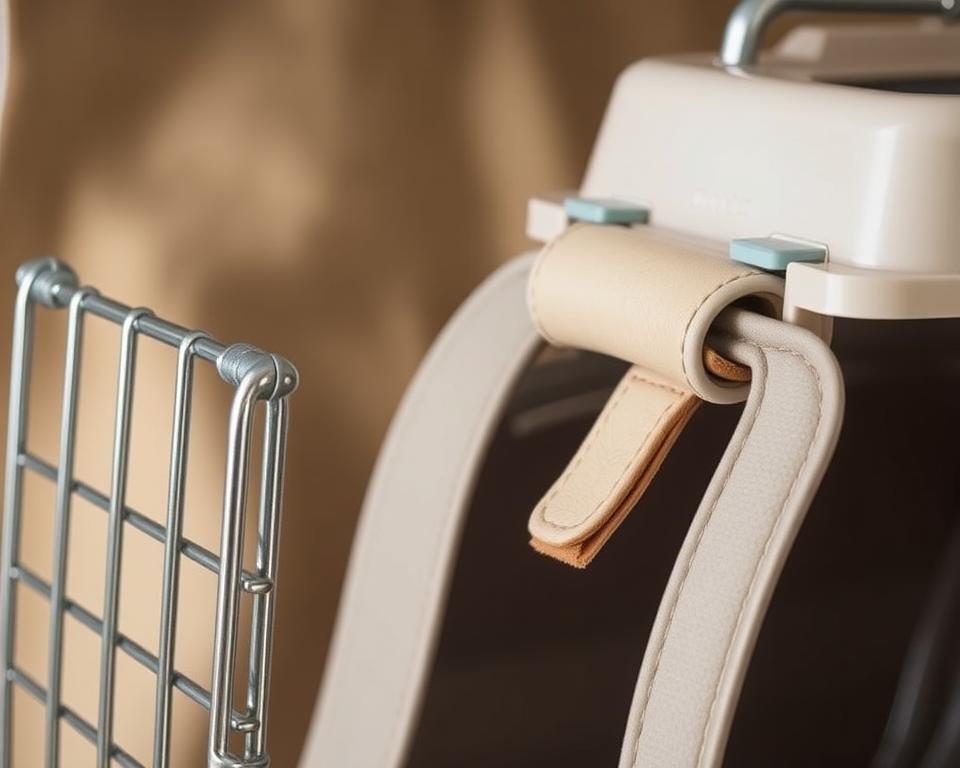
Cat carriers come in different materials, each with its own benefits and drawbacks. The material affects the carrier’s durability, how easy it is to clean, and your cat’s comfort.
Plastic vs Fabric Options
Plastic carriers are tough and easy to clean. They’re great for travelers because they can handle rough handling. Fabric carriers, however, are lighter and more comfy for cats. They’re flexible and easier on the joints but might not last as long as plastic ones.
Key considerations include how easy it is to clean, how durable it is, and your cat’s comfort. If you choose a fabric carrier, pick one with a strong frame and water-resistant material to make it last longer.
Weather-Resistant Considerations
Weather resistance is key if you’ll be traveling with your cat outside. Look for carriers that can handle different weather. Carriers with water-resistant fabric or plastic are perfect for rainy or snowy days.
Also, think about carriers with good air flow. This keeps your cat cool in warm weather. A carrier with good ventilation ensures your cat stays comfy, no matter the temperature outside.
Ventilation and Visibility Features
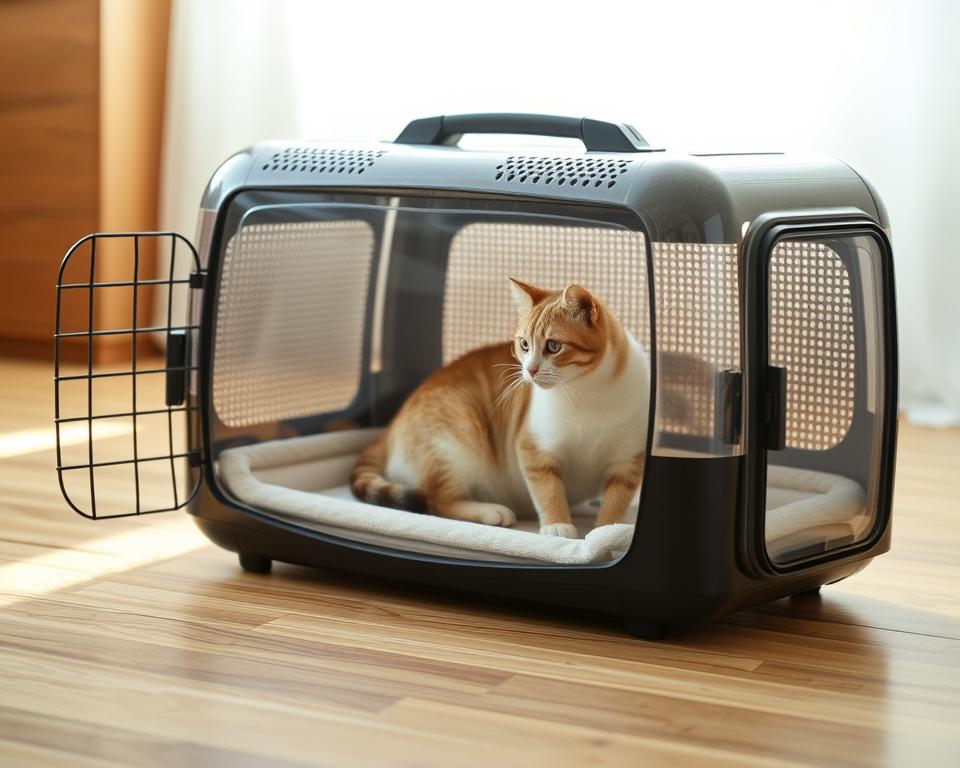
Good ventilation and visibility are key in a cat carrier. They help reduce stress and prevent overheating. A well-ventilated carrier keeps your cat comfortable on trips.
Importance of Air Flow
Adequate air flow is vital to prevent overheating and stress in cats. Carriers with mesh panels or windows offer the needed ventilation. This keeps your cat cool and calm.
Some benefits include:
- Reduced risk of overheating
- Minimized stress through constant airflow
- Improved overall comfort for your cat
When choosing a cat carrier, look for ones with multiple mesh panels. This maximizes ventilation. You can find many cat carriers with great ventilation at holistapet.com.
Finding the Balance Between Privacy and View
Cats need to feel secure and have privacy, but they also benefit from seeing their surroundings. A good cat carrier balances privacy and visibility. Look for carriers that offer:
- Covered tops or privacy panels for security
- Mesh sides or windows for visibility
Ease of Use: Entry Points and Accessibility
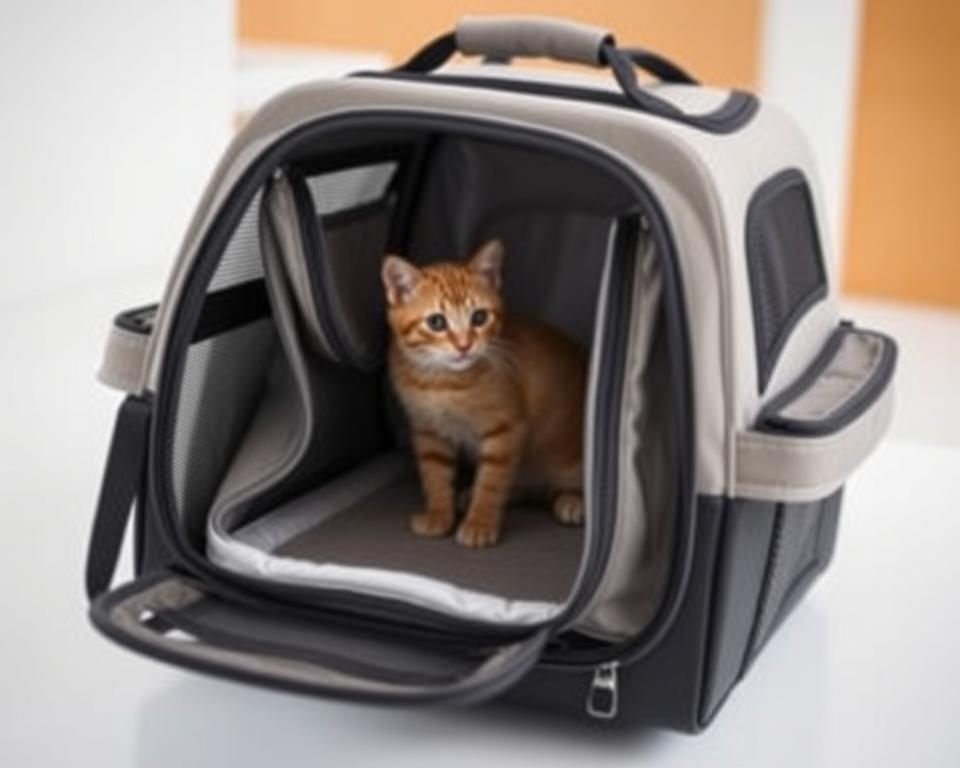
It’s important for both you and your cat to be comfortable when traveling. Carriers with easy entry points and quick-release features help make trips less stressful.
Top-Loading vs Front-Loading Designs
The design of a cat carrier greatly affects its ease of use. Top-loading carriers let you place your cat inside without a scary front opening. In contrast, front-loading carriers have bigger doors for easier access, especially for nervous or mobility-challenged cats.
- Top-loading carriers are more secure for your cat.
- Front-loading carriers are better for cats with mobility issues.
Quick Access Features for Emergencies
Having quick access features is crucial in emergencies. Carriers with quick-release zippers or detachable parts allow for fast exit if needed. Choose a carrier that balances security with easy access.
- Look for carriers with quick-release mechanisms.
- Consider carriers with multiple exit points for added safety.
By focusing on ease of use and accessibility, you can make travel more enjoyable for both you and your cat.
Characteristics of a Good Cat Carrier for Different Journeys
Different journeys need cat carriers with special features for your cat’s comfort and safety. Whether it’s a quick vet visit or a long trip, the right carrier is key.
Vet Visits and Short Trips
For vet visits, a carrier that’s easy to carry and quick to access is vital. Look for top-loading or front-loading designs for easy in and out. Ventilation is also key to keep your cat calm. Choose a carrier with good airflow and visibility to lower stress.
Long-Distance Travel Requirements
For long-distance travel, a bigger and more comfy carrier is needed. Your cat should be able to stand, turn, and lie down easily. Look for extra padding or a soft interior. The carrier must also be secure and stable to avoid tipping.
Check out meoggy.com for a range of cat travel carriers for long trips.
- Ensure the carrier has enough ventilation to avoid overheating.
- Choose a carrier that’s easy to clean in case of accidents.
- Consider a carrier with a secure locking mechanism to prevent escape.
Multi-Cat Transport Solutions
For transporting multiple cats, a carrier with separate spaces is crucial. Look for multi-cat carriers with dividers or separate compartments. These carriers keep your cats safe and comfortable. Make sure the carrier is big enough for all your cats with enough room to move.
“The key to stress-free cat travel is choosing the right carrier for your journey.”
By thinking about your journey’s specific needs, you can pick a cat carrier that ensures your cat’s comfort and safety. Whether it’s a short vet visit or a long trip, the right carrier is essential.
Airline Approved Cat Carriers: What You Need to Know
Traveling by air with your cat requires the right carrier. Always check with the airline for their specific needs. Choose a carrier that meets these standards for a smooth journey.
International and Domestic Flight Requirements
Airlines have different rules for cat carriers, especially for international flights. It’s crucial to know the dimensions, material, and ventilation requirements. For domestic flights, the rules might be less strict, but still, ensure your carrier is approved.
Some key considerations include:
- The carrier should be well-ventilated and provide enough space for your cat to stand, turn, and lie down.
- It should be sturdy and secure to prevent any accidents during the flight.
- Soft-sided carriers are often preferred for their flexibility and ease of storage under seats.
Top Airline Approved Options
Many cat carriers are approved by airlines. Here are some top options:
Soft-Sided Airline Approved Carriers
Soft-sided carriers are popular for their convenience and comfort. Some top brands include:
- Sherpa Deluxe Pet Carrier: Known for its durability and comfort, this carrier is approved by most airlines.
- Pet Gear Deluxe Soft-Sided Carrier: Offers excellent ventilation and is easy to carry.
Hard-Shell Airline Approved Carriers
Hard-shell carriers offer extra protection. Some recommended brands are:
- Petmate Skyline Kennel: Made from durable plastic and provides excellent ventilation.
- Vari-Kennel Pet Carrier: Offers a secure and comfortable space for your cat.
For more information on the best travel carriers for cats and small dogs, you can visit The New York Times Wirecutter for a comprehensive review.
| Carrier Type | Brand | Key Features |
|---|---|---|
| Soft-Sided | Sherpa Deluxe | Durable, Comfortable, Airline Approved |
| Hard-Shell | Petmate Skyline | Durable Plastic, Excellent Ventilation |
Cat Carrier Backpacks: The Modern Solution
For cat owners on-the-go, cat carrier backpacks have changed how we travel with our pets. They offer a convenient, comfortable, and safe way to move around with your cat.
Benefits of Hands-Free Transport
One big plus of cat carrier backpacks is the hands-free transport they offer. This is great for pet owners who have to deal with crowded places or long trips. It keeps your cat safe and lets you move around easily.
Having your hands free is also super useful when you’re on the go. Whether you’re at an airport or just need to pick up something, it makes a big difference.
Features to Look for in Quality Backpack Carriers
When picking a cat carrier backpack, look for a few key things. These include good ventilation, clear viewing windows, and how the weight is spread out.
Ventilation and Viewing Windows
Good airflow is key to keep your cat comfy while you’re out. Choose backpacks with mesh or breathable materials. Also, make sure there are clear windows so your cat feels secure and you can check on them.
Weight Distribution and Comfort
A good cat carrier backpack should spread the weight right, making it comfy for you and your cat. Look for padded straps and a supportive back to help with long walks.
| Feature | Importance | Benefits |
|---|---|---|
| Ventilation | High | Keeps your cat cool and comfortable |
| Viewing Windows | Medium | Provides your cat with a sense of security |
| Weight Distribution | High | Ensures comfort for both you and your cat |
Budget-Friendly vs Premium Cat Carriers: Is It Worth the Splurge?
There are many cat carriers out there, from cheap to expensive. It’s important to know what each offers. Cat owners often wonder if they should spend more on a better carrier or save money.
Value for Money Analysis
For those on a tight budget, a cheap cat carrier might be a good choice. But, it’s key to check if it’s comfy and safe for your cat. Premium carriers, on the other hand, have cool features like better air flow and strong materials.
Comparing cheap and expensive cat carriers can help you decide. Here’s a table showing some main differences:
| Feature | Budget-Friendly | Premium |
|---|---|---|
| Material | Basic Plastic or Fabric | High-Quality, Durable Materials |
| Ventilation | Limited Ventilation Options | Advanced Ventilation Systems |
| Comfort | Basic Padding | Enhanced Comfort Features |
| Price | £20-£50 | £80-£150 |
Long-Term Investment Considerations
Even though cheap carriers seem good at first, think about the long run. Premium carriers last longer and make travel safer and less stressful for your cat.
Buying a high-quality cat carrier is a smart long-term choice. It might cost more upfront, but it’s better for your cat’s health and happiness. This could even mean fewer vet visits.
Introducing Your Cat to Their New Carrier
A new carrier can be scary for your cat. But, with the right steps, it can become a safe place. It’s all about making the carrier a comfortable spot for your cat.
Training Techniques for Stress-Free Entry
To make introducing your cat to their carrier easy, start by placing it in a room they like. Keep the door open so they can explore at their own speed. You can make it more inviting by putting treats or toys inside.
For more tips, check out this article on introducing cats to carriers.
Creating Positive Associations
It’s important to make your cat feel good about their carrier. You can do this in a few ways, including:
- Using Treats and Toys: Put your cat’s favourite treats or toys inside to make it a fun place.
- Gradual Exposure Methods: Start with short times in the carrier and gradually increase it.
Using Treats and Toys
Using treats and toys is a great way to make your cat like their carrier. By putting these inside, your cat will start to see the carrier as a good thing.
Gradual Exposure Methods
Gradual exposure means getting your cat used to the carrier little by little. Begin by letting them get familiar with it. Then, encourage them to go inside it. Finally, they’ll be ready to travel in it.
As “positive reinforcement techniques, such as treats and toys, can create a stress-free experience” for introducing your cat to their carrier, patience and consistency are key. With time, your cat will not only get used to but also enjoy their carrier.
Maintenance and Cleaning of Your Cat Carrier
Keeping your cat carrier clean is key to your pet’s health. A clean carrier stops bacteria and smells from building up. It also makes sure your cat is comfy when you’re on the move.
Routine Cleaning Procedures
It’s important to have a cleaning schedule. First, take out any bedding or litter. Then, use mild detergent and warm water to clean all parts. If your carrier has fabric, a gentle wash cycle might work. But always check the maker’s guide first.
Tips for Effective Cleaning:
- Use a soft-bristled brush for hard spots.
- Make sure the carrier is dry after cleaning to avoid dampness.
- Check the carrier often for any damage.
Dealing with Accidents and Odours
Accidents can still happen, even with the best care. If your cat has an accident, clean it right away with a safe cleaner. For smells that won’t go away, try baking soda or a pet smell remover.
| Odour Removal Method | Effectiveness | Ease of Use |
|---|---|---|
| Baking Soda | High | Easy |
| Pet Odour Neutralizers | Very High | Moderate |
| Vinegar Solution | Moderate | Easy |
Conclusion: Finding Your Perfect Cat Carrier
Choosing the right cat carrier is a personal choice. It depends on your cat’s needs and what you prefer. A good cat carrier must be comfortable, safe, and easy to use.
When looking for the perfect cat carrier, think about size, material, ventilation, and how easy it is to get in and out. Hard-sided and soft-sided carriers have their own benefits. The best one for you will depend on your cat’s needs and your lifestyle.
By considering these points and getting your cat used to the carrier slowly, you can make travel stress-free for both of you. Finding the perfect cat carrier is about finding a balance. It’s about making sure your cat is comfortable and safe while meeting your needs, leading to a happy journey together.







